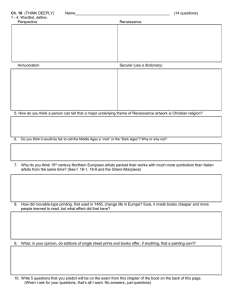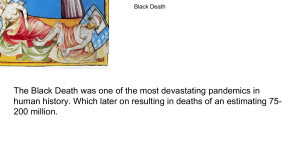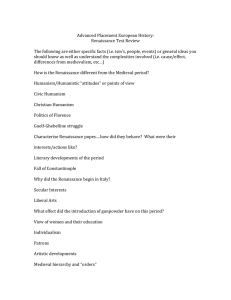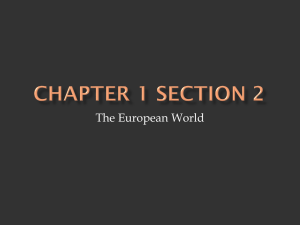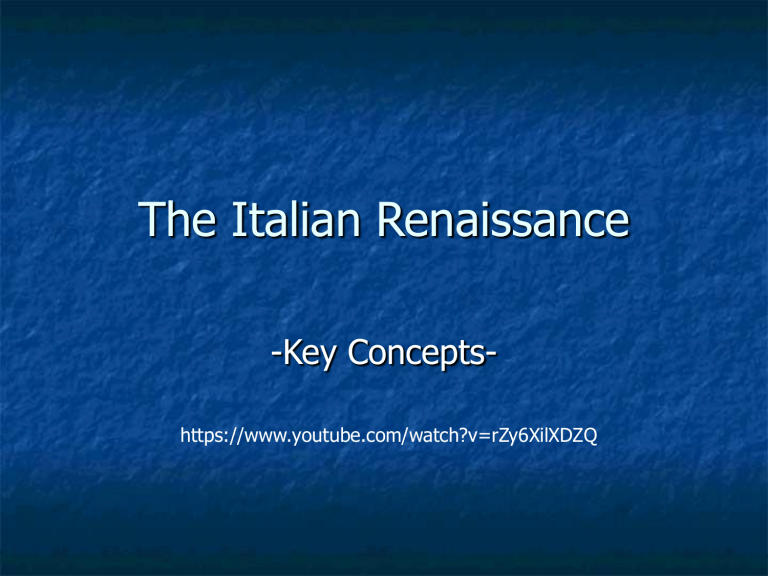
The Italian Renaissance -Key Conceptshttps://www.youtube.com/watch?v=rZy6XilXDZQ Why in Italy at this Time? Peninsula w/large and safe ports Perfect location for commerce w/Asia Feudalism had less of a grip on Italy Two competing lords for control of Italy were losing influence Presence of antiquity was stronger in Italy than elsewhere in Europe European Economic Recovery Dramatic recovery of European commerce Plague created need for labor. Workers could charge more. Important industries flourish in Northern Italy The significance of printing and mining as new industries The fifteenth-century banking empire of the Medici family in Florence Renaissance Economics Profit-making became more important than Church doctrine To overcome guilt, profitmakers indulge in philanthropy Influence of guilds declining High profits led to economic diversification Renaissance Economics (cont) “Cottage Industry” Art became the way to advertise economic success Intensified commercial competition created the need to be efficient Renaissance Politics Same pattern and problems as those of the Greek city-states Inter-city warfare led to new advances in diplomacy -- “balance of power” Northern Italian “communes” The Peace of Lodi (1454) Renaissance Politics (cont) Rome, Venice, Milan, Florence, and the Kingdom of Naples Renaissance Venice Renaissance Florence --Lorenzo the Magnificent (1449-1492) 1300’s republicanism became 1400’s despotism—with the exception of Venice Renaissance Politics (cont) Niccolo Machiavelli (14691527) -- “The Prince” The goal of the prince must be power Cynical view of human nature Fear is a better motivator than affection Politics as the art of deception Renaissance Politics (cont) Ancient and contemporary examples of effective political leaders --Cesare Borgia A new realism in political thought 1400’s “Civic” humanism Leonardo Bruni’s The New Cicero Henry VIII as a Renaissance prince Spread of Humanism to the Rest of Europe The significance of Gutenberg’s printing press Explosion of printed materials --By 1500, 40,000 titles printed and between 8-10 million copies The impact of movabletype printing presses: research and literacy Spread of Humanism to the Rest of Europe (cont) Popular publications in the early days of the printing press Thomas More --Utopia --Executed by Henry VIII in 1535 Erasmus—Dutch Christian Humanist Art & Artists • 1280-1400 proto-Renaissance. Artists begin to look back at Roman Culture • Effort stopped by Plague • 1400’s on Artists again start look to past for inspiration Art & Artists • Artists came from all levels of Society • Worked under a Master as apprentice • Joined a guild • Often worked for Patrons (wealthy supporters) • Painted religious pictures, as well as, domestic themes like marriage, birth, nature, and everyday life. Michelangelo 1475-1564 • World famous sculptor, painter, and architect • Painted the ceiling of the Sistine Chapel • Included his own portrait in the painting • Created the world’s most famous sculpture, David. • First person to publish an autobiography • Known for his bad temper http://www.vatican.va/various/cappelle/sistina_vr/index.html Leonardo Da Vinci 1452-1519 • Painted two of the most famous paintings in the world, Mona Lisa and The Last Supper • Painter, writing, sculptor, inventor. • Changed how painters used light and perspective. • Came up with idea for the helicopter, parachute, airplane, tank, and more • Good at everything he did. Considered the ideal Renaissance Man. • Created modern scientific drawing • May have had dyslexia Vitruvian Man William Shakespeare 1564-1616 • Poet and Playwright • Considered the greatest writer in the history of the English Language, if not of all languages. • Wrote around 38 plays and 154 Sonnets, plus other items. • Has been translated into every living language in the world • Plays have been performed on every Continent
